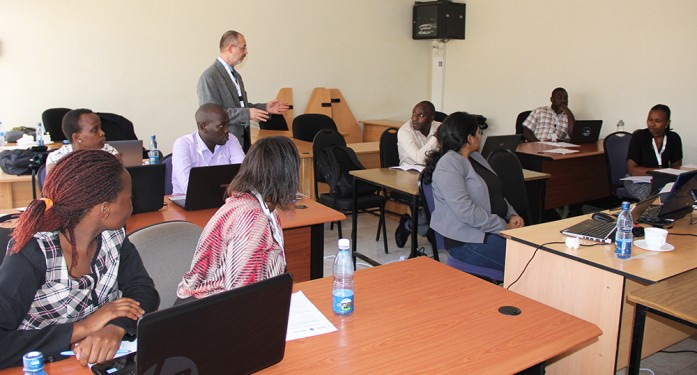
RCMRD/SERVIR E&SA held a three-day training on stream flow forecasting methodologies titled Hydrological Modelling using a Multi-Model Approach from 13-15 March, 2017 in Nairobi, Kenya. The objective of the workshop was to transfer skills required to RCMRD/SERVIR E&SA staff for the implementation of a similar system in Tanzania
being facilitated by the SERVIR Water Africa Arizona Team (SWAAT) team from the University of Arizona.
Speaking during the opening ceremony, Dr. Robinson Mugo, SERVIR-E&SA Project Manager asserted that decision-makers need tools and data for predicting floods and droughts as well as for monitoring the availability of water in support of food security, livelihoods, energy, and more, and that they also need information to plan for future impacts of a changing climate.
In his opening remarks, Prof. John Kiema, Director, Technical Services Directorate at RCMRD, wished the participants fruitful interactions and encouraged them to be active learners. He acknowledged the partnership with NASA and USAID saying it was very important to the Centre as it enabled RCMRD to fulfill its mandate of capacity building.
The training was on the methodologies for stream flow forecasting using a multi-model approach. This approach is used in flood and drought monitoring and forecasting for regions with generally low data availability and capacity is possible based on readily available satellite products and modeling technologies. The SWAAT team provides near real-time streamflow forecasts for several pilot basins in Africa and their main sub-watersheds, as well as displays of recent rainfall over the basins as captured by different satellite precipitation products.
Prof. Juan B. Valdes, SERVIR Applied Sciences Team member (University of Arizona) said of SWAAT, “it is answering specific needs reported from the field, such as the lack of quantitative tools to estimate water availability at resolutions useful to decision-making and our team thus developed tailored applications to fill that gap.” Prof. Valdes notes these activities and the training workshop are the last steps in the transfer of the final applications and tools and in building capacity within the RCMRD center staff. He adds, “This is the last workshop for this project that started in 2012 and is concluding this August. Throughout the duration of the project we have benefited from the hospitality, friendship and advice of the RCMRD professionals and staff. We are here to continue our collaboration with a small team so that we hand over the products-such as near-real time streamflow forecasts, which are readily available to end-user communities and the public.”
The team has developed a project website to display and access the monitoring and forecasting results and related information. The site provides the near real-time streamflow forecasts for the pilot basins and their main sub-watersheds. It also features displays of recent rainfall over the basins as captured by different satellite precipitation products. The SWAAT platform is running, in operational form (forecast.rcmrd.org and www.swaat.arizona.edu )
Georgia Mwendwa, a training participant from the Ministry of Water and Irrigation, Kenya, highlighted the importance of the training, saying, “It has been very useful to me as a hydrologist. It had never occurred to me that the methods could be combined and utilized online as a one stop methodology. I thank the SWAAT team for developing a state-of-the-art tool for forecasting streamflow and the availability of water.”
“The challenge for our group and the forecasting community is to translate this potential into reliable and robust forecasts that can provide early-warning of flood and droughts events in regions with the most need” said Faith Mitheu of RCMRD/SERVIR-E&SA after the training.
Rushi Begum from SERVIR SCO was happy that participants who didn’t have knowledge on the models before the training were now able to use them efficiently in their work.
Other participants were drawn from institutions such as the Water Resources Management Authority (WRMA), Kenya Meteorological Department (KMD) and expressed great interest in the innovative methods and applications demonstrated at the training. This was a collaborative effort between the Department of Hydrology and Atmospheric Sciences at the University of Arizona, SERVIR Program and RCMRD.














